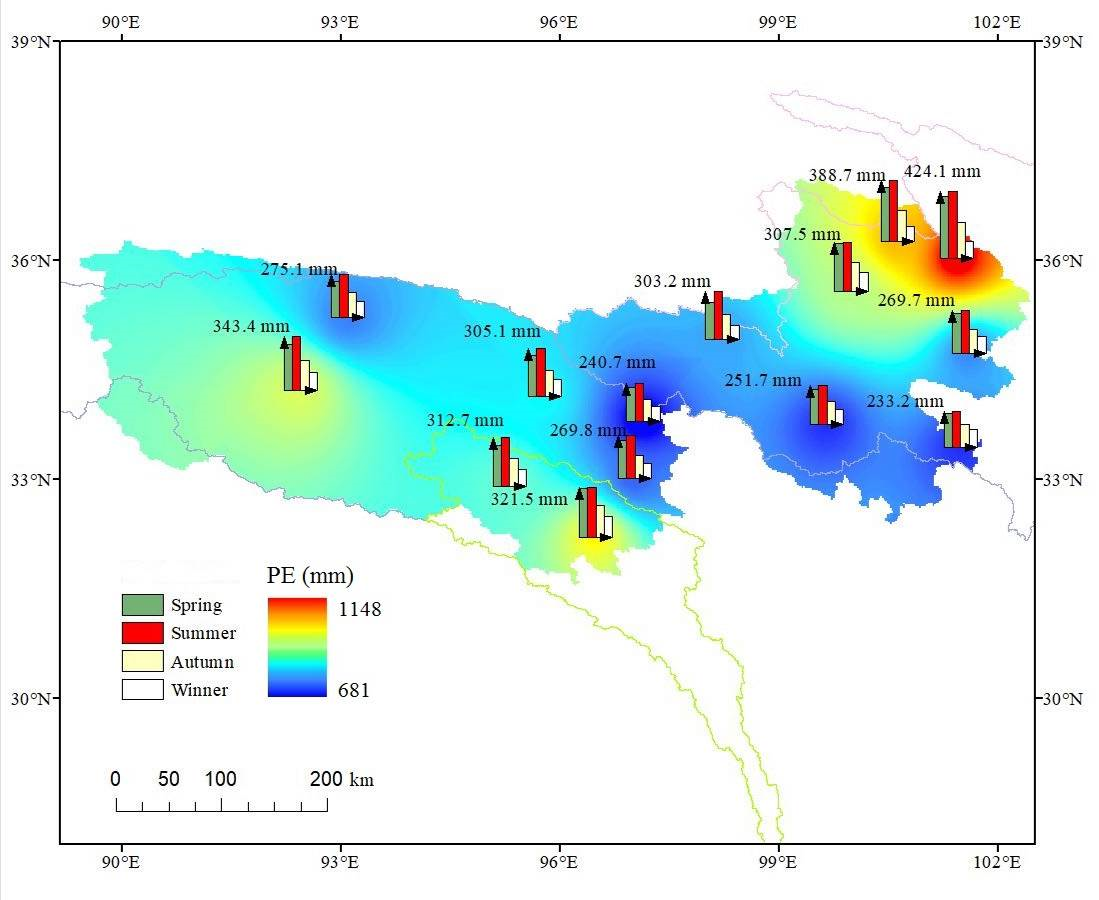Recently, Dr. Haiyun Shi’s group from the School of Environmental Science and Engineering at the Southern University of Science and Technology (SUSTech) has achieved a series of research progress in the field of hydrology and environmental science. Five research papers have been published in the top journals, such as Water Resources Research, Journal of Geophysical Research: Atmospheres, and Environmental Research Letters.

The first paper, entitled “Characteristics of propagation from meteorological drought to hydrological drought in the Pearl River Basin,” was published in the Journal of Geophysical Research: Atmospheres. In this study, the Pearl River Basin (PRB) was classified into five sub-regions with similar dry and wet characteristics. The hydrological drought was more serious than meteorological drought in the PRB, and the drought propagation times (DPTs) were 2-6 months (Figure 1). It also noted that large-scale climate patterns (ENSO and PDO) are important factors that affect the DPT from meteorological to hydrological drought in the PRB.

Figure 1. Spatial distributions of (a) the MPCC and (b) the DPT from meteorological drought to hydrological drought in the PRB.
The second paper, entitled “Investigating the propagation from meteorological to hydrological drought by introducing the nonlinear dependence with directed information transfer index,” was published in Water Resources Research. In this study, a directed information transfer index (DITI) was introduced in a drought propagation study to build a new drought response time (DRT) evaluation system for the first time (Figure 2). Additionally, trigger thresholds from meteorological to hydrological drought were determined by a drought propagation model. It also illustrated that sub-regions with smaller meteorological drought trigger thresholds had longer durations of hydrological drought events.

Figure 2. Spatial distributions of (a) the DRT-differences between mutual information (MI) and DITI; (b) the values of different months between the DRT-linear and DRT-nonlinear in each grid.
The third paper, entitled “Impacts of dams and reservoirs on local climate change: a global perspective,” was published in Environmental Research Letters. This study explored the impacts of reservoir characteristic factors (RCFs) on local climate change near the reservoir by examining the correlations between the RCFs (e.g., water surface (AREA), storage capacity (CAP), and average depth (DEP)) and meteorological variables (e.g., evaporation (E), precipitation (P), surface temperature (ST), and temperature 2 m above the surface (T2M)) all over the world (Figure 3).
The researchers found that the correlations of the RCFs with evaporation are opposite to those with precipitation. It also observed that dams and reservoirs could have completely opposite (weakening or enhancing) effects on different meteorological variables. Additionally, the RCFs outperformed the geographical factors in terms of the impact on precipitation, whereas the variation of evaporation is more sensitive to geographical factors.

Figure 3. Correlations between the RCFs and meteorological variables in the center-grid of a reservoir.
The fourth paper, entitled “Impacts of regional characteristics on improving the accuracy of groundwater level prediction using machine learning: The case of central eastern continental United States,” was published in the Journal of Hydrology: Regional Studies. This study built a gated recurrent unit (GRU) neural network model for groundwater level simulation (Figure 4). It showed that the input features for the GRU model were effectively determined by the principal component analysis method and summarized the attributes suitable for machine learning simulation. It also exhibited that groundwater autocorrelation had a negative effect on machine learning simulation.

Figure 4. (a) Model workflow; (b) structure of Recurrent Neural Network; (c) structure of Long Short-Term Memory; and (d) structure of Gate Recurrent Unit.
The fifth paper, entitled “Evolution characteristics of potential evapotranspiration over the Three-River Headwaters Region,” was published in Hydrological Sciences Journal. This study investigated the evolution characteristics of potential evapotranspiration (PET) over the Three-River Headwaters Region (TRHR) based on observations at fourteen stations during 1960-2014.
The research team analyzed the spatial-temporal changes at annual and seasonal scales (Figure 5) and built machine learning models to predict the monthly PET. The outcomes can help to understand better the future hydrometeorological conditions in the TRHR, which would be valuable for better protection of the ecological environment in this region.

Figure 5. Spatial distributions of the mean annual PET and the seasonal PET over the TRHR from 1960 to 2014.
Dr. Haiyun Shi is the corresponding author of all five papers. The first authors of these papers are all members of Dr. Shi’s group, including Ph.D. candidates Zhaoqiang Zhou and Hejiang Cai, master’s graduate Zhipeng Jiang, and research assistant Yiyang Zhao.
These studies were supported by the National Natural Science Foundation of China (NSFC), Basic and Applied Basic Research Foundation of Guangdong Province, Guangdong Provincial Key Laboratory of Soil and Groundwater Pollution Control, and State Environmental Protection Key Laboratory of Integrated Surface Water-Groundwater Pollution Control.
Related papers (In order of appearance above):
Journal of Geophysical Research: Atmospheres:
https://agupubs.onlinelibrary.wiley.com/doi/10.1029/2020JD033959
Water Resources Research:
https://agupubs.onlinelibrary.wiley.com/doi/10.1029/2021WR030028
Environmental Research Letters:
https://iopscience.iop.org/article/10.1088/1748-9326/ac263c
Journal of Hydrology: Regional Studies:
https://www.sciencedirect.com/science/article/pii/S2214581821001592
Hydrological Sciences Journal:
https://www.tandfonline.com/doi/full/10.1080/02626667.2021.1957105
To read all stories about SUSTech science, subscribe to the monthly SUSTech Newsletter.
Proofread ByAdrian Cremin, Yingying XIA
Photo By